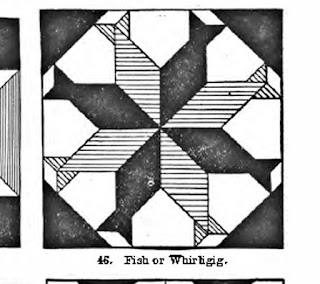Martha Spark called my attention to this quilt shown at a MOKA meeting.
(Missouri, Oklahoma, Kansas, Arkansas Study Group)
Looks to be about 1880-1910 by the fading solid colors. Wonder
what the tan once was. Red would have been a stunner. The question: Any ideas on the pattern?
I finally found the block
1075.2 in BlockBase
Fox & Geese from Clara Stone
It seems to me that Clara included both the block and the sashing in her illlustration.
The block is a square in a square. The sashing a form of flying geese.
Maybe she intended the quilt to look like this.
UPDATE: Mandy drew it up in BlockBase & EQ. Above her Fox & Geese design.
The illustration conventions of Clara Stone's day made it hard
to show anything but a block.
Which is what the quiltmaker saw.
She then added her own square in a square sashing.
See some pattern relatives at this post:
Here's Mandy's version in EQ
I've never known much about Clara A. Stone of Holliston, Massachusetts. I didn't have a copy of her her catalog and never collected many of her newspaper pattern clippings. Wilene Smith is the expert and she has figured out that "C.A.S." of Holliston often contributed pattern designs to periodicals published by Vickery and Hill of Augusta, Maine.
Vickery & Hill was an important publisher with magazines including Hearth & Home, Good Stories and American Woman. Stone mailed patterns to Vickery between 1897 and 1905.
Then in May, 1906 another publisher, C.W. Calkins of Boston, published Quilt Patterns by Clara A. Stone in their series Practical Needlework. The booklet contained illustrations of Stone's patterns without text.
Some of the authors for Calkins and Vickery used pen names, but one gets the feeling there really was a Clara A. Stone of Holliston because she had long contributed patterns with her initials. However, no one's found any other evidence of Clara A. Stone.
Stone was an influential source for quilt patterns in the early 20th century. Her designs were often the first published source for patterns later picked up by other designers. Stone's Fish or Whirligig, for example, has been republished many times over the past 110 years.
About 20 years after Stone's catalog Ruby McKim
published her Fish Block.
And in 1937 the Chicago Tribune columnist Loretta Leitner writing as Nancy Cabot described an "old and frequently made pieced block suddenly has been given a modern title. Years ago it was known simply as 'Fish Block,' but some enterprising quilt maker decided that it should be given a more specific appellation, hence 'Trout and Bass' block."
Nancy made things up out of whole cloth. The block was neither very old nor very frequently made. I bet both she and McKim had copies of the Clara Stone booklet.
Louisiana Project & the Quilt Index.
Fell off a truck and was rescued.
Louisiana Project by Alma McCall
Top from the Iowa Project
I looked in the Quilt Index for examples of the Fish Block and found about a half a dozen, all made after 1930, probably from McKim's or Cabot's designs. I'd imagine that Clara Stone designed many of the blocks like the fish block herself.
Appliqued and pieced star quilt, mid-19th century
from a Quilt Engagement Calendar
You can certainly see its origins in 19th century quilts but there is nothing quite like it until after she published the pattern.
You can have a copy of Clara Stone's innovative booklet as a free PDF here:


















Loved seeing the MOKA quilt mystery solved. And thank you for the link to the Clara Stone booklet. Downloaded and savored. Thank you!
ReplyDeleteThat's a lovely block. And thank you for the PDF booklet - I did enjoy the bottom part "A fascinating and useful occupation is that of weaving real linen Torchon lace" - I wonder how many took Mary Bradford's offer as a result of the link at the back?
ReplyDeleteThat is actually my quilt that I brought to the meeting. I found it thrown in a corner of an antique shop in Oklahoma.
ReplyDeleteThe Antique Pattern Library is a wonderful resource! They are a small nonprofit run by dedicated volunteers. They've recently received donated scans of some early Workbasket Magazines, and have obtained permission from the current copyright holder to post them. I'm looking forward to seeing those soon. Dot
ReplyDeleteif this was WWII, the fish block could have been named "Bombs Away"
ReplyDeleteThank you for your continued great work bringing the beautiful block patterns to life again in6 this shared PDF.
ReplyDelete